Layout and formatting
Layout and formatting options for the score can be accessed mainly from the Layout and Style menus.
Ways to affect layout
This section lists the main commands and dialogs affecting score layout. Other formatting options are covered in either Layout menu or Style menu below (for text, see Text styles and properties).
From the Layout menu:
-
Page Settings: Adjust the overall dimensions of your score such as page size, page margins, and scaling.
-
Increase Stretch/Decrease Stretch: Adjust the score spacing by stretching or squashing selected measures.
From the Style menu:
-
Score Style: Set overall score details, such as music font, display of multi-measure rests, and whether to hide empty staves.
-
Page Style: Adjust staff and system spacing, score and lyric margins etc.
-
Measure Style: Set the measure spacing, which affects the number of measures per line.
-
Sizes: Set the default size of "small" and grace notes, small staves and small clefs.
Other commands:
-
Add/Remove line breaks: Set the number of measures per system.
-
Breaks and spacers: Apply line, page or section breaks. You can also add extra space between particular systems or staves where needed.
Layout menu
Page Settings...
See Page settings.
Reset
The Reset command restores all selected score elements to their default position. It also restores the default directions of note stems and beams. To apply:
- Select the elements or the region of the score that you wish to reset. Or use Ctrl+A to select the whole score.
- Press Ctrl+R; or from the menu select Layout→Reset.
Increase Stretch/Decrease Stretch
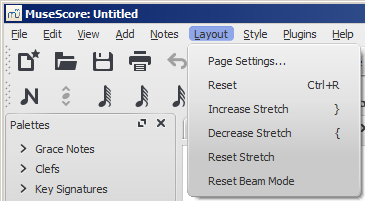
Increase or decrease the horizontal spacing of notes within selected measures. To apply:
- Select a range of measures. Or use Ctrl+A to select the whole score.
- Chose one of two options:
- To increase stretch:
- Use the shortcut } (right curly bracket) (Mac: Ctrl+Alt+9);
- Or from the menu bar, select Layout→Increase Stretch;
- To decrease stretch:
- Use the shortcut { (left curly bracket) (Mac: Ctrl+Alt+8);
- Or from the menu bar, select Layout→Decrease Stretch.
- To increase stretch:
See also Measure Properties: Layout stretch. This allows you to set the stretch more precisely.
Reset Stretch
To reset stretch to the default spacing of 1:
- Select a range of measures. Or use Ctrl+A to select the whole score.
- From the menu, select Layout→Reset Stretch.
Reset Beam Mode
To restore beams to the mode defined in the local time signatures:
- Select the section of the score you want to reset. If nothing is selected, the operation will apply to the whole score;
- Select Layout→Reset Beam Mode.
See also Beams.
Regroup Rhythms
As of version 2.1, this option corrects note ties, durations and beaming so that they are grouped according to standard music notation practice. For example:
Before:

After:

Any notes that are tied and are the same length as a dotted note will be changed to the dotted note with two limitations. (i) Only the last note of a group of tied notes will have a single dot. Notes with more than one dot are not produced using this option. (ii) Dotted notes will not span from one group of beamed notes to another unless their duration is the same as all of the beam groups it covers. Any notes with more than one dot will be regrouped according to the above rules.
To apply:
- Select the section of the score you want to reset. If nothing is selected, the operation will apply to the whole score;
- Select Layout→Regroup Rhythms.
Note: This is an experimental feature and there are known bugs. Articulations and ornaments are deleted and some pitches respelt. Ties across barlines may be lost on UNDO.
Style menu
General: Score
To open the Score dialog: from the menu, select Style→General...→Score.
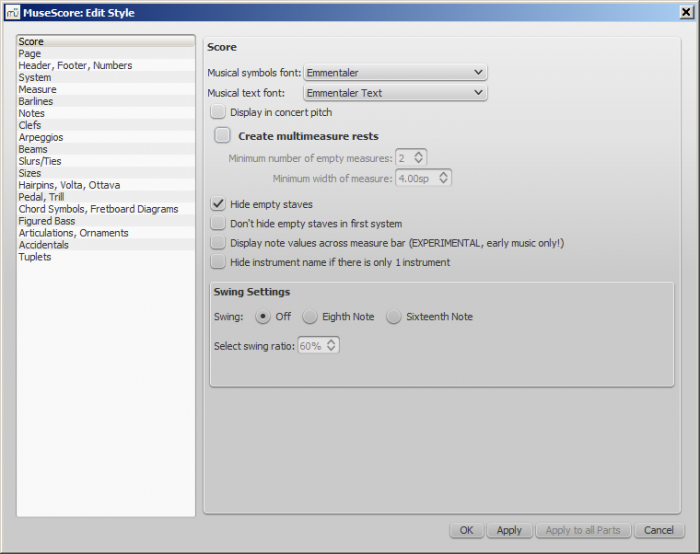
This dialog allows you to set global properties, such as the music font, display of multimeasure rests, whether or not to hide empty staves, "swing" playback etc.
- Musical symbols font: Choice of display in Emmentaler, Bravura or Gonville fonts.
-
Musical text font: Choice of display in Emmentaler, Bravura, Gonville or MuseJazz fonts.
-
Display in concert pitch: Tick this option to display the score at concert pitch. If unticked the score is displayed at written pitch.
-
Create multimeasure rests: Tick to display multimeasure rests.
- Minimum number of empty measures; The default is 2.
- Minimum width of measure: The default width is 4 sp.
-
Hide empty staves: This option saves space by hiding those staves in a system which consist of only empty measures. Used for condensed scores.
-
Don't hide empty staves in first system: Always display staves in first system even if they consist of empty measures.
-
Display note values across measure bar: A feature useful for notating early music. See Unbarred notation.
-
Hide instrument name if there is only one instrument: You don't usually need to display the instrument name in this case.
-
Swing setting: The default is off. Choice of swung eighth or sixteenth notes.
- Select swing ratio: The default setting is 60%.
See also, Swing
General: Page
To open the Page dialog: from the menu, select Style→General...→Page.

This dialog allows you to adjust the space above and below systems, staves, lyrics, and vertical frames; and between the score and the top/bottom page margins. You can also control the display of key signatures, time signatures and clefs.
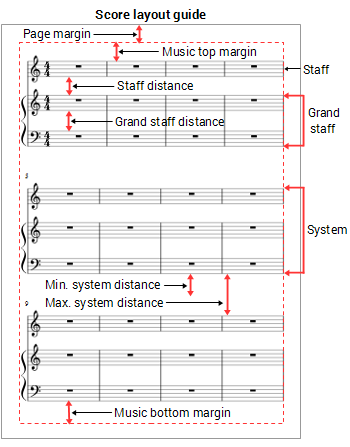
Distance to page margins
- Music top margin: The distance between the top staff line of the first staff on the page and the top page margin.
- Music bottom margin: The distance between the bottom staff line of the last staff on the page and the bottom page margin.
Distance between staves
- Staff distance: The space between staves which are not part of a grand staff (see below).
- Grand staff distance: The space between staves that share the same instrument—such as the piano, organ, or those of a guitar staff/tab pair.
Note: To alter the space above one particular staff see Extra distance above staff (Staff properties).
Distance between systems
- Min. system distance: The minimum distance allowed between one system and the next.
- Max. system distance: The maximum distance allowed between one system and the next.
Lyrics Margins
- Lyrics top margin: The height of the margin above the top lyrics line (in a system).
- Lyrics bottom margin: The height of the margin underneath the bottom lyrics line (in a system).
- Lyrics line height: The distance between lyrics line (in a system), expressed as a percentage of the line height associated with the lyrics text style.
Vertical frame margins
- Vertical frame top margin: The default margin height above a vertical frame.
- Vertical frame bottom margin: The default margin height below a vertical frame.
Last system fill threshold
- If the last system is longer than this percentage of the page width, it gets stretched to fill that width.
Clefs and key signatures
- Create clef for all systems: Untick this box to prevent a clef from automatically displaying at the start of any system except the first.
- Create key signature for all systems: Untick this box to prevent a key signature from automatically displaying at the start of any system except the first.
Ticking the following boxes, allows the display of courtesy elements at the end of systems:
- Create courtesy time signatures:
- Create courtesy key signatures
- Create courtesy clefs
General: Header, Footer, Numbers
Open from the menu: Style→General...→Header, Footer, Numbers.
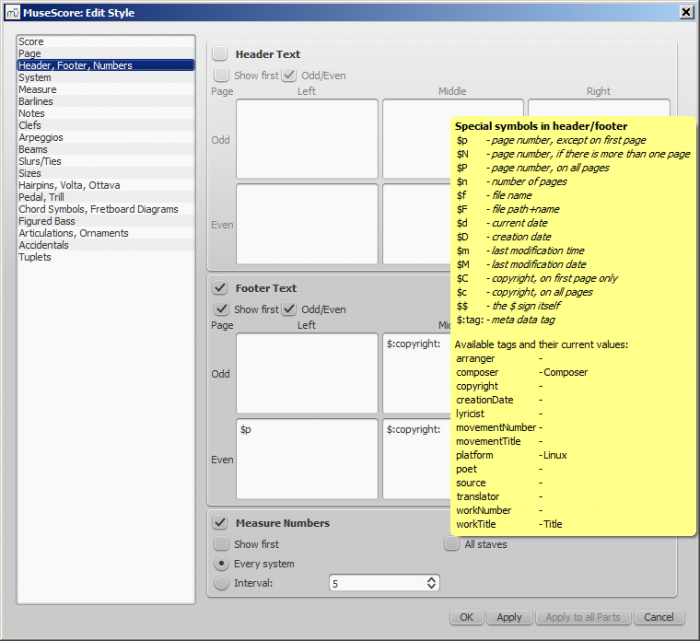
You can show the content of a score's meta tags (see Score information) or show page numbers in a header or footer for your score. To create a header or footer for a score with linked parts, make sure the main score is in the active tab. To create a header or footer for an individual part, that part needs to be the active tab.
If you hover with your mouse over the Header or Footer text region, a list of macros will appear, showing their meaning, as well as the existing meta tags and their content.
You can create different Headers and Footers for even and odd pages, such as putting page numbers on the right for odd-numbered pages and on the left for even-numbered pages.
You can also edit whether and how often measure numbers appear.
General: System
Open from the menu: Style→General...→ System.
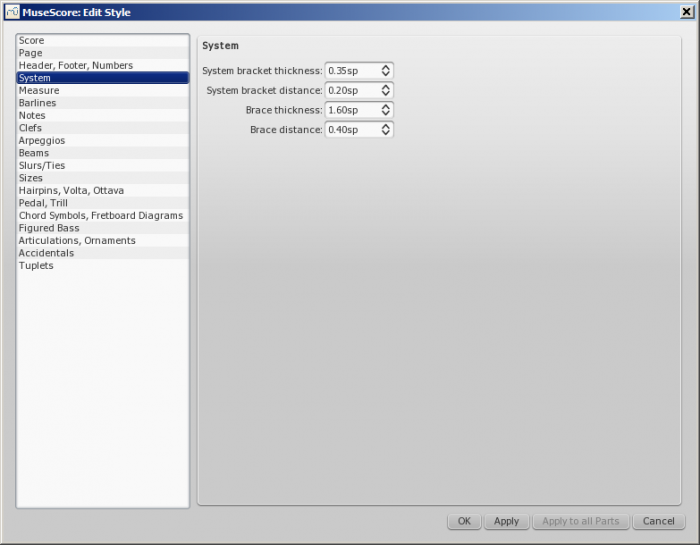
This dialog allows you to:
- Set the distance between system brackets or braces and the start barlines.
- Set the width of system brackets and braces.
See also Brackets.
General: Measure
General: Barlines
Open from the menu: Style→General...→Barlines.
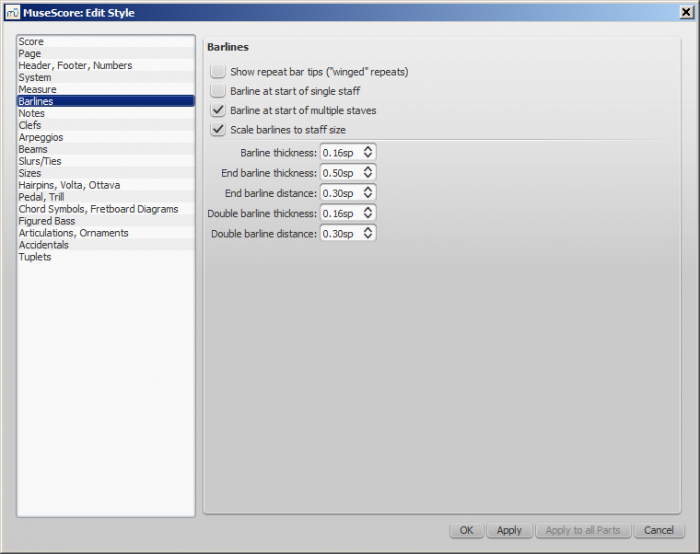
- Control whether to show barlines at the beginning of a staff or multiple staves.
- Scale barlines to staff size affects "small" staves only. See Barline adjustment possibilities (external link) for details.
- Control proportion of thickness and distance within double barlines, including repeat barlines.
General: Notes
Open from the menu: Style→General...→Notes.

This page can also be accessed direct from the score by right-clicking on any note and selecting "Style…" Here you can adjust the distance and thickness of note-related objects (stems, ledger lines, dots, accidentals). Changing these would be unusual.
General: Clefs
Open from the menu: Style→General...→Clefs.

You can choose between Serif and Standard clef for your tablature sheet.
General: Arpeggios
Open from the menu: Style→General...→Arpeggios.
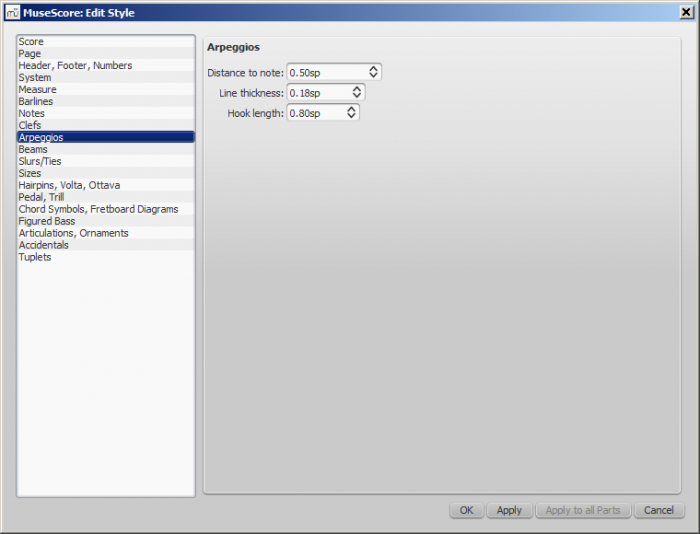
Here you can change the thickness, spacing and hook height of the following arpeggio and strum symbols:

Changes to these properties would be unusual.
General: Beams
Open from the menu: Style→General...→Beams.
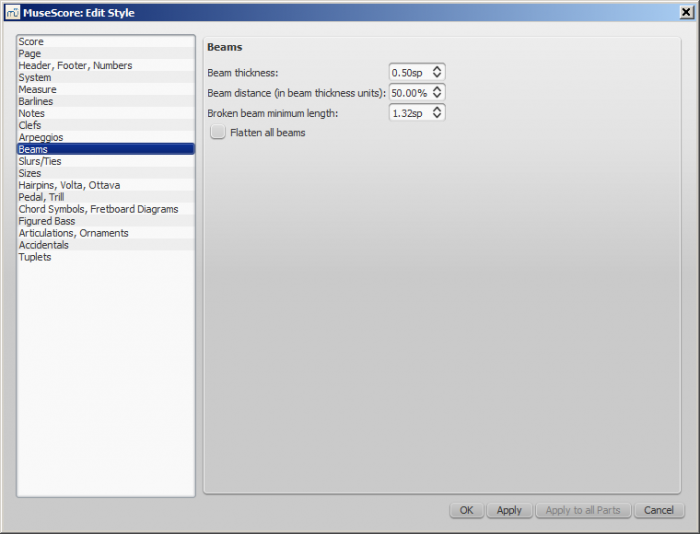
General: Slurs/Ties
Open from the menu: Style→General...→Slurs/Ties.

General: Sizes
Open from the menu: Style→General...→Sizes.
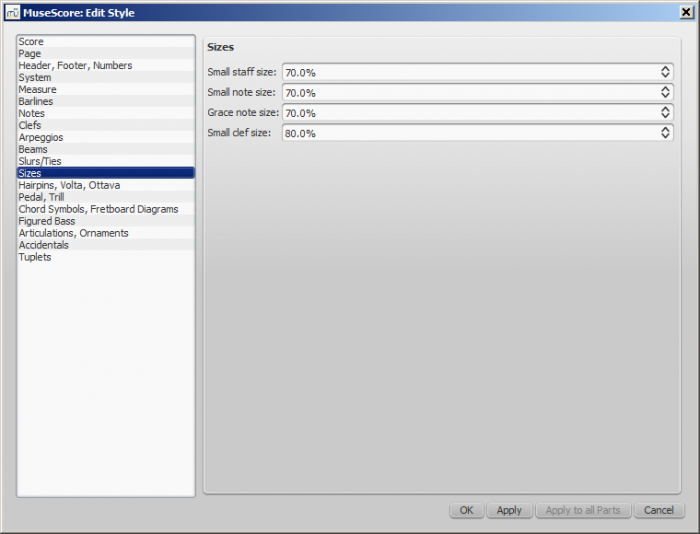
Sets the proportional size of "small" and grace notes, as well as small staves and clefs. Changing this would be unusual.
General: Hairpins, Volta, Ottava
Open from the menu: Style→General...→Hairpins, Volta, Ottava.
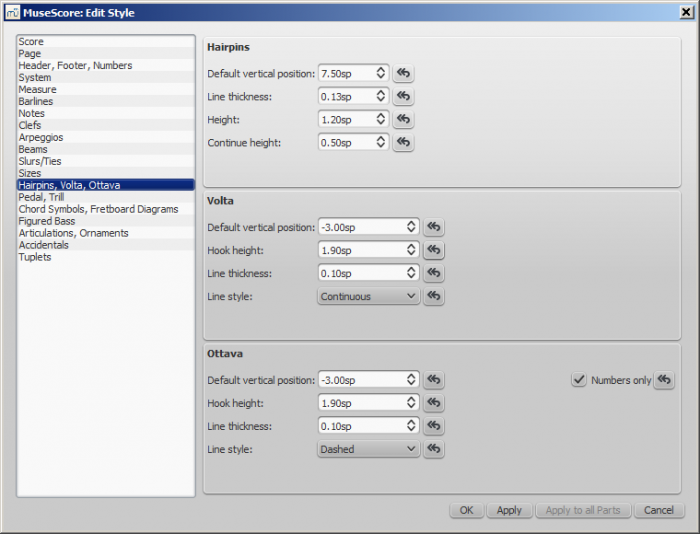
The  button returns the setting to the original value.
button returns the setting to the original value.
General: Pedal, Trill
Open from the menu: Style→General...→Pedal, Trill.
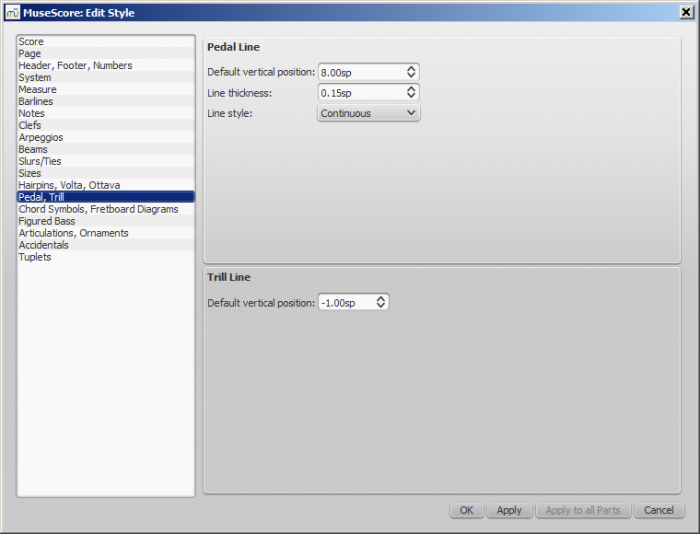
General: Chord Symbols, Fretboard Diagrams
Open from the menu: Style→General...→Chord Symbols, Fretboard Diagrams.
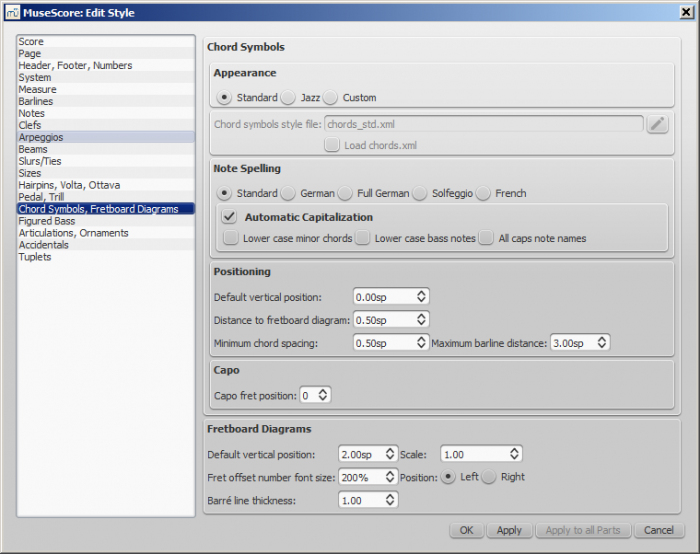
This section allows you to adjust the format and positioning of chord symbols and Fretboard diagrams.
Appearance: Chose a default chord symbol style—Standard, Jazz or Custom.
Note Spelling: Chose the spelling convention for chord symbols and whether to use capital or small letters.
Positioning:
- Default vertical position: The default vertical distance in space units (sp.) between a newly-applied chord symbol and the music staff. Negative values may be used.
- Distance to fretboard diagram: The distance (in sp. units) from a chord symbol to a fretboard diagram when both are applied to the same location on a staff. This value overrides the above "Default vertical position" setting. The user can chose to place a chord symbol below a fretboard diagram by entering a negative value.
- Minimum chord spacing: The minimum space to allow between chord symbols.
- Maximum barline distance: Increases the distance between the final chord symbol in a measure and the following barline. You may wish to adjust this value if there is a recurring problem in the score with overlap between the final chord symbol in one measure and the following chord symbol.
Capo: Enter the number of the capo position at which you want to display substitute chords, in brackets, for all chord symbols in the score.
Fretboard diagrams:
- Default vertical position: the distance in sp. units from a newly applied fretboard diagram to a staff. A negative value may be used.
- Scale: Increase or decrease the size of the fretboard diagram in the score.
- Fret offset number font size: Increase or decrease the size of a fret number displayed next to a diagram.
- Position Left/Right: Display fret number to the left or right of the fretboard diagram.
- Barre line thickness: Make barre lines in fretboard diagrams thicker or thinner.
General: Figured Bass
Open from the menu: Style→General...→Figured Bass.
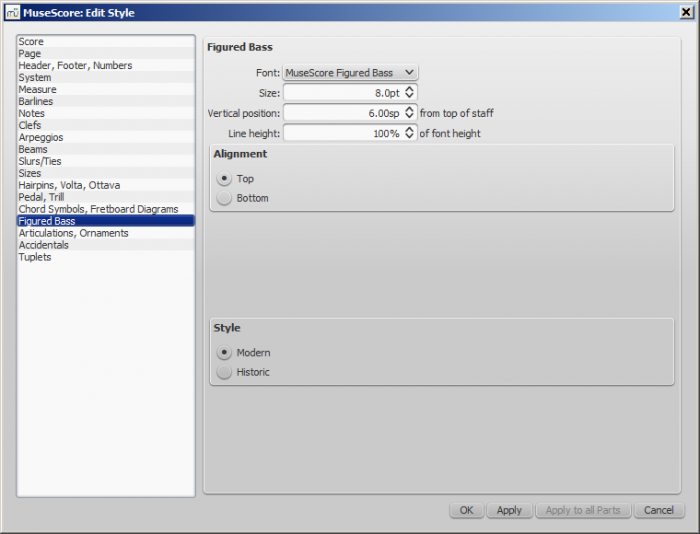
Options about figured bass font, style and alignment.
See also Figured bass
General: Articulations, Ornaments
Open from the menu: Style→General...→Articulations, Ornaments.
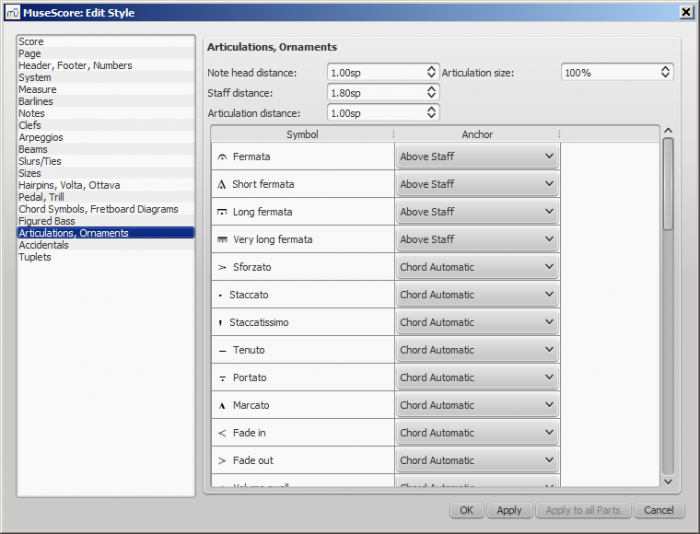
Position of articulation with respect to the notes and staves
General: Accidentals
Open from the menu: Style→General...→Accidentals.

Options about naturals at key signature changes
General: Tuplets
Open from the menu: Style→General...→Tuplets.
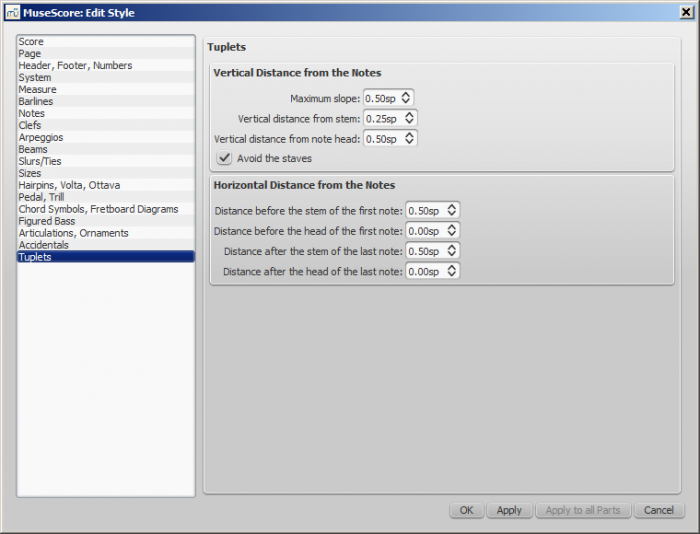
Apply and OK buttons
By pressing the Apply button you can see how the changes you have made in the dialogs affect the score without closing the window. Press OK to save your changes to the score and close the window.
Apply to all parts in one go
When in a part tab while changing layout and formatting, you can use the Apply to all Parts button to apply all changes (either in Layout→Page Settings.... or Style→General...) to apply the new settings to all parts in just one click.
Save/Load style
It is easy to transfer a complete set of styles (all General Style settings, all text styles, and page settings) from one score to the other using the Save/Load Style functions.
To save a customized style:
- Go to Style→Save Style....
- Name and save the style file (the default folder is set in your Preferences). Styles are stored as
*.mssfiles.
Note: You can also define a preferred style for scores and parts in the Score section of MuseScore's Preferences.
To load a customized style:
- Go to Style→Load Style....
- Navigate to and select the Style file (.mss) and click Open (or double click on the file).
All existing styles in the score should update automatically.
See also
External links
- Tutorial – How to create large-print stave notation (MSN)
- MuseScore in 10 Easy Steps: Part 10A Layout and Formatting (a video tutorial)
- MuseScore in 10 Easy Steps: Part 10B Layout and Formatting (a video tutorial)
General style: Measure
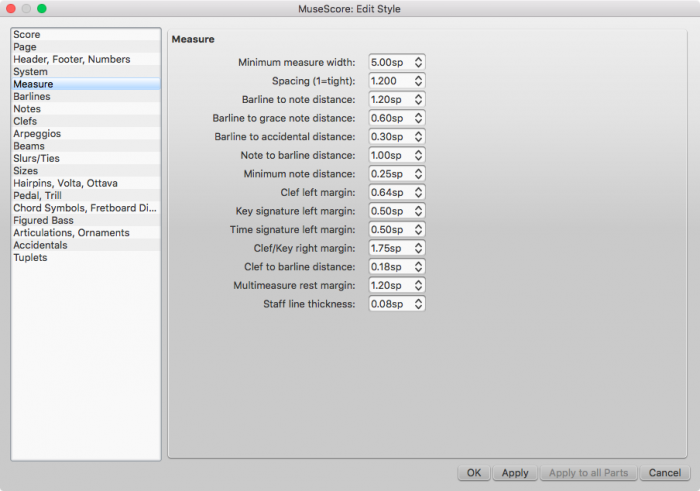
Style → General → Measure allows you to adjust the distance between various items within measures.
Introduction
If you change a measure style property (see image above), MuseScore automatically adjusts the score to maintain the correct spacing between notes and rests according to best music engraving practice. It will also correctly reposition any elements attached to notes or rests, such as fingerings, dynamics, lines etc.
All settings related to measure width and note spacing are minimum values. Measures are automatically stretched, if necessary, to maintain existing page margins.
All the properties listed below use the staff space (abbreviated to "sp") as the basic unit of measurement. See Page settings: Scaling for more details.
Options
-
Minimum measure width
Sets the minimum horizontal length of measures. In measures containing very little content (e.g., a single whole note or whole measure rest), the measure will only shrink as far as this minimum. -
Spacing (1=tight)
Condenses or expands the space after notes or rests. This setting thus affects not only space between notes but also between the last note and the ending barline. For the space between the beginning of the measure and the first note or rest, see Barline to note distance (below).Note: Changes to an individual measure's Stretch (under Layout → Increase Stretch, Decrease Stretch) are calculated after, and proportional to, the global Spacing setting.
-
Barline to note distance
Sets the distance between the barline which begins a measure and the first note or rest in that measure. For the initial measures of systems, which start with clefs instead of barlines, use Clef/key right margin (below). -
Barline to grace note distance
Sets the distance between a barline and a grace note that occurs before the first actual note in a measure (independently of the "Barline to note distance" setting). -
Barline to accidental distance
Sets the distance between a barline and an accidental placed before the first note in a measure (independently of the "Barline to note distance" setting). -
Note to barline distance
(To be added). -
Minimum note distance
Specifies the smallest amount of space MuseScore will allow after each note (depending on other factors, more space may be allowed). -
Clef left margin
Sets the distance between the very beginning of each line and the clef. (This option is rarely needed.) -
Key signature left margin
Sets the distance between the key signature and the clef preceding it. -
Time signature left margin
Sets the distance between the time signature and the key signature or clef preceding it. -
Clef/key right margin
Sets the distance between the material at the beginning of each line (such as the clef and key signature) and the first note or rest of the first measure on the line. (Note that, although not named in the option, if a time signature is present, it is the element from which the spacing begins.) -
Clef to barline distance
Sets the distance between a barline and a clef change preceding it. -
Multi-measure rest margin
Sets the distance between a multi-measure rest and the barlines on either side. -
Staff line thickness
Sets the thickness of the lines of the staff, which allows you to make the staff thicker and darker, if you need greater visibility on your printouts.